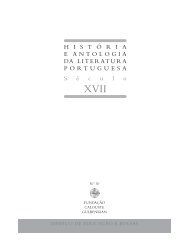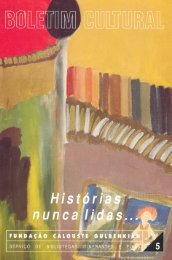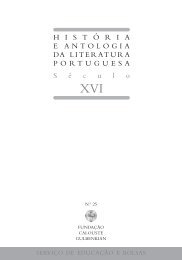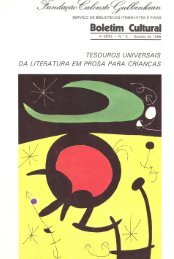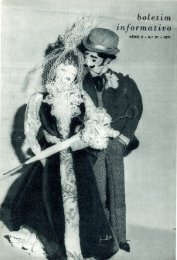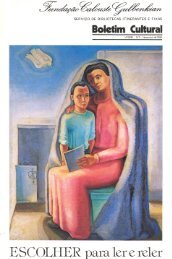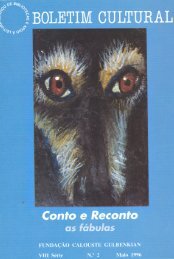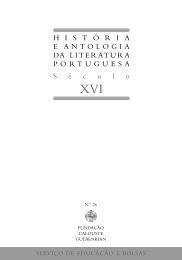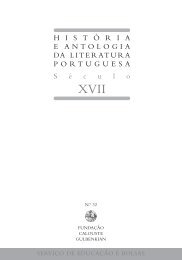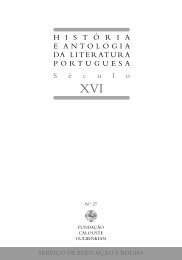Formar Leitores para Ler o Mundo - Leitura Gulbenkian - Fundação ...
Formar Leitores para Ler o Mundo - Leitura Gulbenkian - Fundação ...
Formar Leitores para Ler o Mundo - Leitura Gulbenkian - Fundação ...
Create successful ePaper yourself
Turn your PDF publications into a flip-book with our unique Google optimized e-Paper software.
36<br />
textual features of the picturebook before beginning the story text; and<br />
the subsequent discussion of the story. A second examination of each<br />
transcript identified the children’s conversational turns (Sinclair &<br />
Coulthard 1975) about each se<strong>para</strong>te element of the peritext (for example,<br />
talk about the front cover or the title page). Third, these sections of<br />
children’s talk were analyzed at the level of the conversational turn in<br />
order to conceptually label the purposes and subjects of the discussion.<br />
During a fourth pass through the data, the inductive conceptual labels<br />
were then grouped into conceptual categories representing the major<br />
points of the peritextual discussion, following the three stage model of<br />
Strauss and Corbin (1990). A fifth stage involved the coding of the peritextual<br />
discussion according to the final instantiation of the conceptual categories,<br />
with the two authors coding independently. Interrater reliability<br />
was 94%. Following this, with the assistance of a third coder (a doctoral<br />
student), consensus was achieved about all discrepancies and disagreements.<br />
This process resulted in slight adjustments to the conceptual category<br />
system. Finally, tallies and percentages for each conceptual category<br />
were computed, along with the percentage of peritextual talk (by children’s<br />
conversational turns) for each story and for the data set as a whole.<br />
The finalized list of conceptual categories constituted the ways in which<br />
the children utilized the features of the peritext to make meaning before<br />
the story was read, thus answering the research question.<br />
RESULTS<br />
Results suggest that discussion of peritextual elements before beginning<br />
the reading of the story comprised about 21% of the total student turns<br />
– 712 turns out of a total of 3347 turns – in the readaloud discussions,<br />
suggesting that children, with their teacher’s encouragement, were highly<br />
engaged in peritextual response. We found that there were nine main<br />
ways in which children responded in the initial peritextual discussion:<br />
(1) References to conventions of picturebook construction, production, and reading.<br />
Children demonstrated their knowledge of picturebook conventions in a<br />
number of ways. Perhaps most simply, they named or identified particular<br />
peritextual features such as the dust jacket, front cover, endpapers,<br />
title page, and dedication page. In this way, they were making use of the<br />
metalanguage of picturebooks, enabling them to identify the parts of the<br />
peritext with precision. This metalanguage had been taught to them by<br />
their teachers, who said, for example, «here are the endpages» or «here is<br />
the half-title page». Children also took note of any awards that the books<br />
had won, discussing the significance of the silver or gold Caldecott<br />
medallions appearing on the front cover. For example, in the peritextual<br />
discussion of The Stinky Cheese Man and Other Fairly Stupid Tales (Scieszka,<br />
1992), Julie observed that the book «got a medal». Another child specified<br />
that it was a «Caldecott», and the children elaborated on their understanding<br />
of the award system:<br />
Gordon: Caldecott Honor Book.<br />
Charles: This is second best.<br />
Teacher: Yes, this is silver.<br />
Although the publishing information is not a prominent feature of the<br />
picturebook peritext, the children took great delight in discovering the<br />
book’s date of publication, comparing it to their own birth year. They<br />
were fascinated to find out that most books published in the United<br />
States seem to originate in New York City:<br />
Jim: New York again! Most books must be publishing in New York. It looks<br />
like when they’re makin’ books, most books are made in New York.<br />
The dedication page often inspired talk about to whom a book was dedicated<br />
and hypotheses about the possible reasons for this dedication (in<br />
their own book-writing, children utilized this convention, dedicating<br />
their home-made books to their friends and/or parents).<br />
Finally, the children were accustomed to both the routines employed by<br />
the teachers as they conducted readalouds and the commonly occurring<br />
elements of the peritext. Because their teachers had established these<br />
routines, they insisted that, for example, the teacher remove the dust<br />
jacket of the book in order to see if the board cover duplicated the dust<br />
jacket or was different. They also insisted on examining and speculating<br />
about the endpapers, half-title and title pages, etc. They simply would not<br />
allow teachers to take a brief look at the front cover and then begin reading<br />
the story!<br />
(2) Description.<br />
Children described or labeled details of illustrations within the peritext.<br />
Included here are responses that seem to answer simple «what» or «who»<br />
questions. The title page of Christopher Coady’s (1991) Red Riding Hood<br />
contains an oval vignette of a leafless tree silhouetted against a full<br />
moon. Sean commented, «At first there’s some red strokes over the moon,<br />
[pointing to the branches of the tree] and down here too [pointing to the<br />
lower left edge of the vignette].»<br />
(3) Interpretation and evaluation.<br />
Description was often followed by interpretation. Included in this category<br />
were responses that went beyond simple description and seemed to<br />
37




